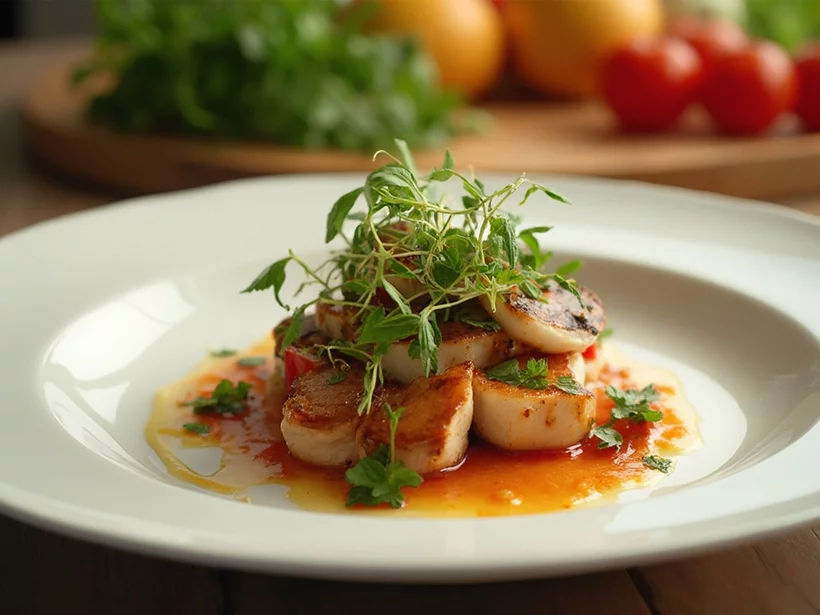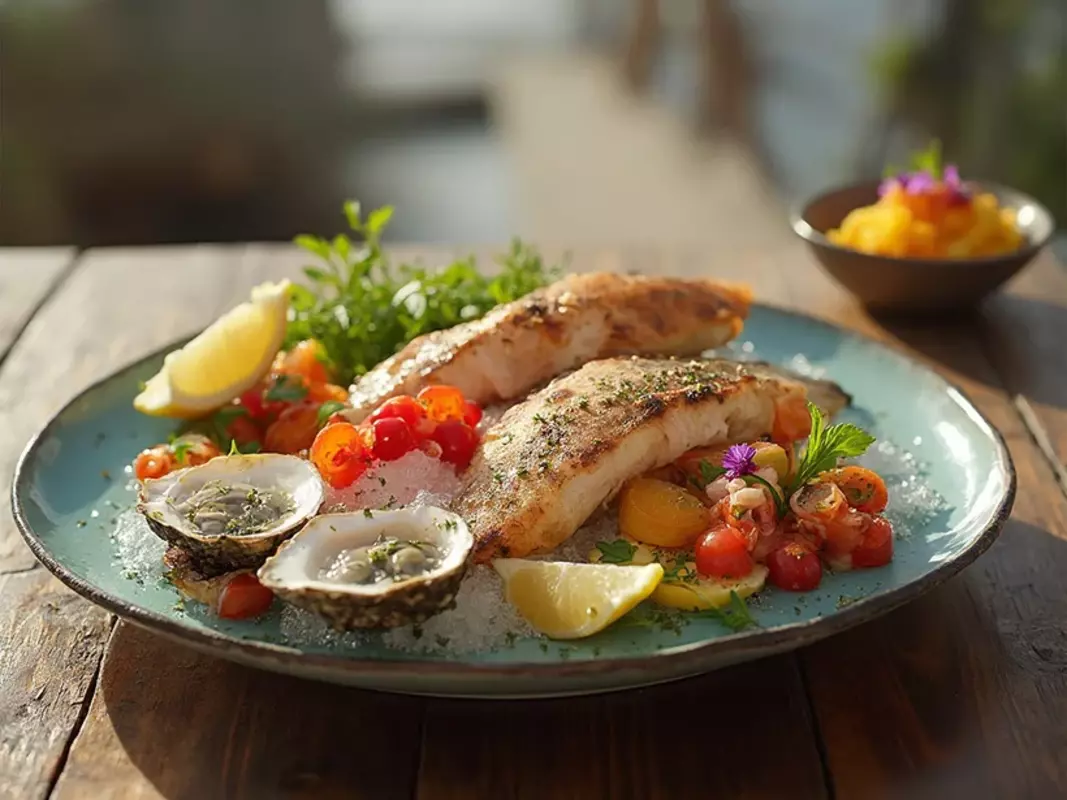Australian Chefs Embrace Seasonal Ingredients

The essence of Australian cuisine lies in its rich tapestry of flavors, deeply rooted in the land and its seasonal offerings. By embracing sustainable practices and local ingredients, we not only preserve the environment but also enrich our dining experiences. Let's explore how these principles shape our plates and our communities.
What You Will Learn
- Seasonal ingredients enhance flavor and freshness, providing a superior dining experience.
- Sourcing locally reduces carbon footprints and supports sustainable farming practices.
- Using native Australian ingredients connects dishes to the cultural heritage and history of the land.
- Dining choices can foster community ties and contribute to a thriving agricultural economy.
Why Seasonality and Sustainability Matter
This visual highlights the key benefits of incorporating seasonal and sustainable ingredients in modern Australian cuisine, focusing on flavor, environmental impact, and community support.
Enhanced Flavor & Freshness
Seasonal ingredients are picked at their peak, ensuring a burst of freshness and richer flavor profiles. This significantly enhances the overall dining experience.
- Peak ripeness
- Superior taste & texture
- Higher nutrient content
Environmental Impact & Sustainability
Sourcing locally and seasonally reduces carbon footprints by minimizing transportation. It also supports sustainable farming practices and promotes biodiversity.
- Reduced carbon footprint
- Supports eco-friendly farming
- Minimizes waste
Support for Local Farmers & Community
Choosing local produce strengthens community ties, fosters a thriving agricultural economy, and provides direct support to dedicated farmers.
- Strengthens local economies
- Builds producer-consumer trust
- Preserves agricultural heritage
Connection to Culinary Heritage
Utilizing native Australian ingredients like bush tomatoes and wattleseed connects dishes to rich cultural history and unique local flavors.
- Unique flavor profiles
- Celebrates indigenous produce
- Tells a cultural story
Understanding the Role of Seasonal and Sustainable Ingredients in Australian Cuisine
At The Yellow Tail Table, I believe that embracing seasonal ingredients not only enhances the flavors of our dishes but also fosters a deeper connection to the land and community. Using ingredients that are in season means we can create authentic dining experiences that resonate with our guests. Moreover, it helps reduce our environmental impact by minimizing transportation and supporting local farmers. Isn’t it wonderful to think that what’s on your plate is a reflection of the current harvest? The Chefs' Manifesto Action Hub in Melbourne, for instance, highlights the growing commitment of culinary professionals to these principles.
When we prioritize seasonality, we also gain access to produce at its peak freshness and flavor. This commitment to sustainable practices not only benefits our health but also the ecosystem around us. By choosing to work with seasonal ingredients, we are taking a step toward responsible dining, which is at the heart of modern Australian cuisine, as further discussed in research on sustainable food systems and dietary recommendations.
Why Seasonality Matters for Modern Menus
Incorporating seasonal ingredients into our menus brings a lively vibrancy and authenticity to every dish. Here are a few reasons why seasonality is crucial:
- Flavor Profile: Seasonal produce is often more flavorful and nutrient-rich, enhancing the overall dining experience.
- Environmental Impact: Sourcing locally reduces carbon footprints and supports sustainable farming practices.
- Freshness: Ingredients picked at their prime offer superior taste and texture, making every meal a delightful experience.
As I create new recipes, I often look to local markets to see what’s fresh. This way, I can craft something special that celebrates the essence of Australian cuisine, inspiring those who visit The Yellow Tail Table to appreciate the beauty of every season.
Connecting Cuisine with Culture: The Use of Native Australian Ingredients
The richness of Australian cuisine is beautifully complemented by our native ingredients. Exploring indigenous produce like bush tomatoes, wattleseed, finger lime, and lemon myrtle allows us to connect deeply with our culinary heritage. These ingredients not only provide unique flavors but also represent the rich culture and history of Australia, as explored in discussions around cooking with native ingredients.
- Bush Tomatoes: These small, tangy fruits bring a punch of flavor to sauces and dressings.
- Wattleseed: With its nutty aroma, it can enhance baked goods and savory dishes alike.
- Finger Lime: This zesty fruit adds a burst of acidity and texture to seafood dishes.
- Lemon Myrtle: Known for its lemony flavor, it pairs beautifully with both sweet and savory recipes.
By incorporating these native ingredients into my cooking at The Yellow Tail Table, I strive to honor the land and its stories. Each dish becomes a canvas, celebrating the flavors that make our Australian cuisine truly remarkable!
This video, while not directly about top chefs' insights, focuses on sustainable and seasonal ingredients, which aligns partially with your request.
Pro Tip
To truly celebrate the essence of Australian cuisine, consider experimenting with native ingredients in your cooking. Incorporating bush tomatoes or finger limes into your dishes not only enhances flavor but also connects you to the rich cultural heritage of Australia. Next time you cook, visit a local market to discover these unique ingredients and elevate your culinary creations!
Frequently Asked Questions (FAQs)
- Q: Why are seasonal ingredients important in Australian cuisine?
- A: Seasonal ingredients are picked at their peak ripeness, offering superior flavor, freshness, and nutrient content, which significantly enhances the dining experience.
- Q: How do sustainable practices benefit the environment?
- A: Sustainable practices, such as local sourcing, reduce carbon footprints by minimizing transportation, support eco-friendly farming, and promote biodiversity, thus minimizing waste.
- Q: What are some examples of native Australian ingredients?
- A: Native Australian ingredients include bush tomatoes, wattleseed, finger lime, and lemon myrtle, each offering unique flavor profiles and connecting dishes to the country's rich culinary heritage.
- Q: How can dining choices support local communities?
- A: Choosing local produce strengthens community ties, fosters a thriving agricultural economy, builds trust between producers and consumers, and helps preserve agricultural heritage.
- Q: Where can I learn more about chefs advocating for sustainable food?
- A: Initiatives like the Chefs' Manifesto Action Hub in Melbourne are excellent resources for understanding how culinary professionals are committing to sustainable food systems.
Reflecting on the Importance of Seasonal and Sustainable Practices
As we delve into the vibrant tapestry of modern Australian cuisine, it becomes abundantly clear that seasonal and sustainable ingredients play a crucial role in shaping our culinary landscape. By emphasizing these practices, we not only enhance the flavors of our dishes but also contribute to the health of our environment. Seasonal ingredients bring a freshness that is hard to replicate, while sustainability ensures that we are being responsible stewards of our precious resources.
Incorporating these principles allows chefs to create menus that are not only tasty but also tell a story of connection to local farms and ecosystems. At The Yellow Tail Table, we celebrate this connection by showcasing dishes that highlight fresh, seasonal produce sourced from our dedicated farmers. This approach not only supports local economies but also provides diners with an authentic taste of Australia’s diverse offerings. Isn’t it wonderful to think about how every bite can reflect the land it comes from?
- Enhanced Flavor: Seasonal ingredients are picked at their peak, leading to a burst of freshness.
- Environmental Impact: Sustainable sourcing practices reduce carbon footprints and promote biodiversity.
- Support for Local Farmers: Choosing local produce helps strengthen community ties and fosters a thriving agricultural economy.
Reflecting on these aspects, it’s evident that our dining choices can make a meaningful difference. Each meal becomes an opportunity to support sustainable practices and savor the rich flavors that our land provides. As we embrace this journey at The Yellow Tail Table, we invite you to join us in celebrating the essence of Australian cuisine through sustainable and seasonal ingredients.
Encouragement to Support Local Chefs and Sustainable Dining
Now, more than ever, it’s essential for us to consider how our dining choices impact our community and the environment. I encourage you to explore local restaurants that prioritize sustainable practices and engage with chefs who are passionate about their craft. By supporting these establishments, you play a vital role in promoting a dining culture that values both flavor and sustainability.
Consider making a conscious effort to seek out dishes that feature local produce. Ask your favorite restaurants about their sourcing practices or try cooking with seasonal ingredients in your own kitchen! Here are a few ways you can make a difference:
- Visit local farmers' markets to discover fresh produce and connect with your community.
- Try new restaurants that emphasize seasonal menus and sustainable sourcing.
- Engage with chefs on social media or in person to share your appreciation for their commitment to sustainability.
By choosing to support local chefs and sustainable dining, you’re not just enjoying a meal; you’re participating in a larger movement that celebrates the artistry and responsibility of Australian cuisine. So, let’s embark on this delicious journey together and savor the stories behind every dish! What local flavors will you explore next?
Recap of Key Points
Here is a quick recap of the important points discussed in the article:
- Embrace Seasonal Ingredients: Using ingredients that are in season enhances flavors and supports local farmers.
- Focus on Sustainability: Sustainable practices reduce environmental impact and promote responsible dining.
- Utilize Native Ingredients: Incorporating native Australian ingredients connects culinary heritage with modern dishes.
- Support Local Communities: Choosing local produce strengthens community ties and enhances the dining experience.
- Encourage Sustainable Dining: Explore local restaurants that prioritize sustainability to contribute to a better culinary culture.








